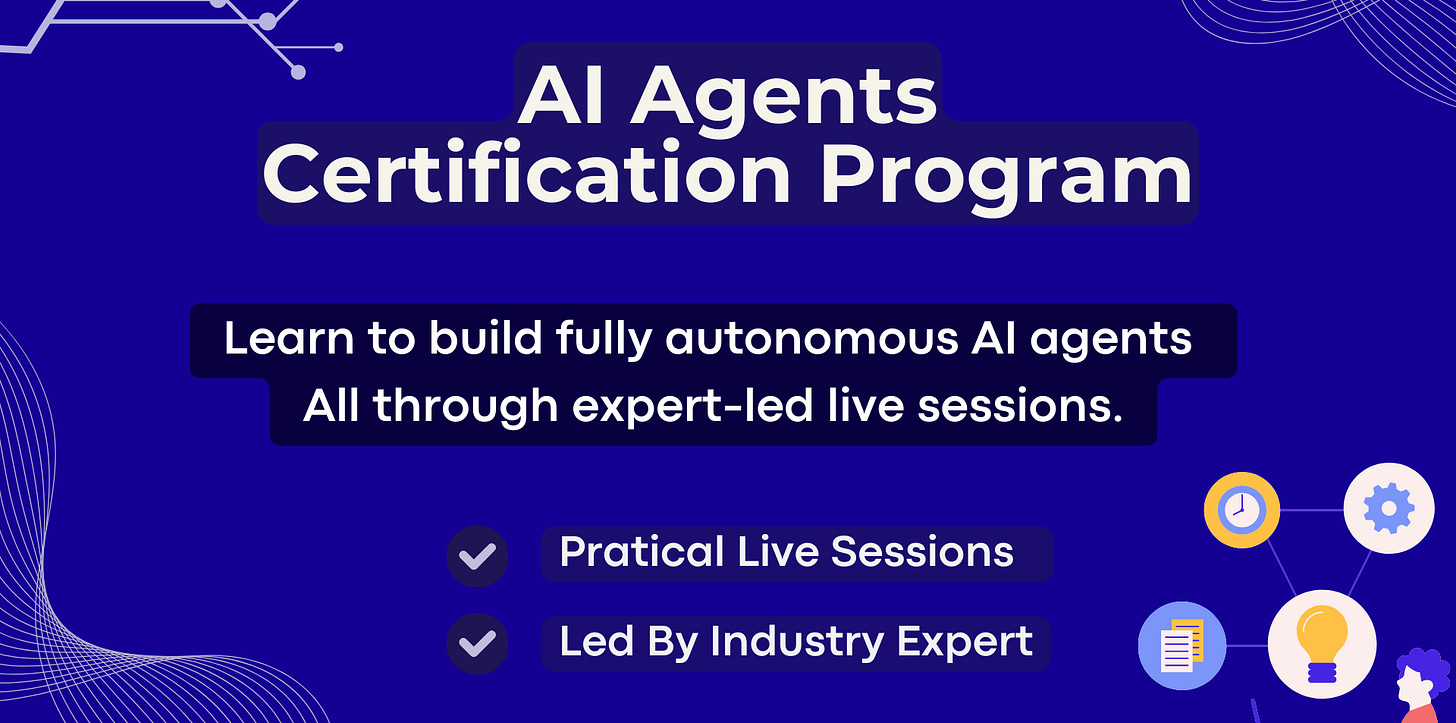Standard Price: $1190 USD
A special price of $890 for readers of Business Analytics Review,
🚀 AI Agents Scholarship Challenge – Earn Your extra 30% Discount! 🚀
We're offering an additional 30% scholarship ( $623 instead of $890 ) to learners who can demonstrate their knowledge of AI Agents!
Answer these 5 challenge questions correctly, and you’ll unlock an exclusive discount to enroll in our AI Agents Certificate Program. ****
🔥Start the AI Agents Challenge Now🔥
Hello !!
Welcome to the new edition of Business Analytics Review!
Today, we’re exploring into a practical topic that many data enthusiasts encounter: Reading JSON files with Pandas.
JSON (JavaScript Object Notation) has become a popular format for data interchange due to its simplicity and readability. Whether you're working with APIs, configuration files, or data exports, knowing how to handle JSON files is essential for any data scientist or analyst.
What is JSON?
JSON is a lightweight data interchange format that is easy for humans to read and write, and easy for machines to parse and generate. It uses a simple key-value pair structure, making it an excellent choice for representing structured data. Here’s a quick example of a JSON object:
json
{
"name": "Alice",
"age": 30,
"city": "New York",
"skills": ["Python", "Data Analysis", "Machine Learning"]
}Why Use Pandas?
Pandas is a powerful Python library for data manipulation and analysis. It provides flexible data structures like DataFrames, which are perfect for handling structured data. Reading JSON files into Pandas allows you to leverage its powerful data manipulation capabilities, making it easier to analyze and visualize your data.
How to Read JSON Files with Pandas
Let’s walk through the steps to read a JSON file using Pandas.
Install Pandas: If you haven't already installed Pandas, you can do so using pip
Import the Library: Start by importing the Pandas library in your Python script or Jupyter notebook.
Read the JSON File: Use the pd.read_json() function to read your JSON file. You can specify the path to your JSON file as follows.
Explore Your Data: Once the JSON file is loaded into a DataFrame, you can explore it using various Pandas functions
pip install pandas
import pandas as pd
df = pd.read_json('path/to/your/file.json')
# Display the first few rows of the DataFrame
print(df.head()) Handling Nested JSON
Sometimes, JSON files contain nested structures. In such cases, you might need to normalize the data using pd.json_normalize(). Here’s how you can do it:
import json
# Sample nested JSON
data = '''
{
"name": "Alice",
"age": 30,
"address": {
"city": "New York",
"state": "NY"
},
"skills": ["Python", "Data Analysis"]
}
'''
# Load the JSON string into a Python dictionary
json_data = json.loads(data)
# Normalize the nested structure
df = pd.json_normalize(json_data)
print(df)
This will flatten the nested structure into a more manageable format.
🚀 AI Agents Scholarship Challenge – Earn Your extra 30% Discount! 🚀
******* We're offering an additional 30% scholarship ( $623 instead of $890 ) to learners who can demonstrate their knowledge of AI Agents!
Answer these 5 challenge questions correctly, and you’ll unlock an exclusive discount to enroll in our AI Agents Certificate Program. *********
🔥Start the AI Agents Challenge Now🔥
Practical Example
Imagine you are working with an API that returns user information in JSON format. By reading this data into a Pandas DataFrame, you can easily filter users based on specific criteria, analyze their skills, or visualize their information using libraries like Matplotlib or Seaborn.
Recommended Reads
How to Read JSON Files in Python - This article provides an overview of reading JSON files in Python using various methods. Read more here
Working with JSON Data in Pandas - A detailed guide on how to manipulate and analyze JSON data using Pandas. Read more here
Pandas Documentation: Reading JSON Files - The official documentation from Pandas on reading and writing JSON files. Read more here
Latest News in AI and Data Science
Palantir Technologies: The AI Powerhouse Reshaping Data Analytics
Read more here
‘The future of AI belongs to those who turn data into action’: Qlik CEO Mike Capone
Read more here
How AI & Data Literacy Addresses the GenAI Critical Thinking Challenge
Read more here
Recommended Tool for Working with JSON
Jupyter Notebook is an open-source web application that allows you to create and share documents containing live code, equations, visualizations, and narrative text. It’s particularly useful for interactive data analysis and visualization tasks involving libraries like Pandas.
Website: Jupyter Notebook
Thank you for joining me in this exploration of reading JSON files with Pandas! I hope you found this edition informative and engaging. Until next time, keep coding!
Standard Price: $1190 USD
A special price of $890 for readers of Business Analytics Review,
🚀 AI Agents Scholarship Challenge – Earn Your extra 30% Discount! 🚀
**** We're offering an additional 30% scholarship ( $623 instead of $890 ) to learners who can demonstrate their knowledge of AI Agents!
Answer these 5 challenge questions correctly, and you’ll unlock an exclusive discount to enroll in our AI Agents Certificate Program. ****
🔥Start the AI Agents Challenge Now🔥





